How to protect your camera in snow | protect your camera in cold weather
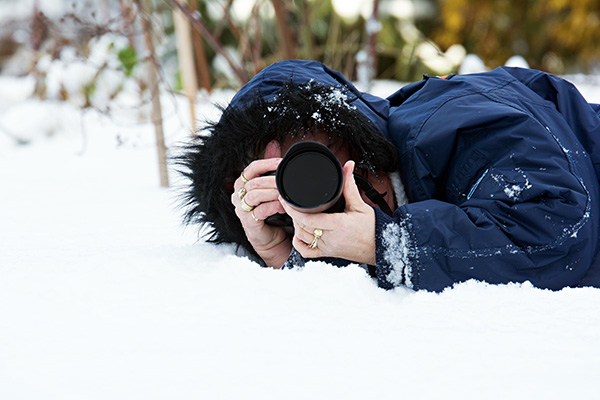
Source: Royalty-free stock photo ID: 551251480, Shutterstock
It’s true – most modern photography equipment is generally durable enough to withstand snowy conditions, but there are still some best practices that you’ll want to keep in mind when handling your photography gear in snow and cold weather conditions. Let’s review those in this post.
Tips to protect your camera in snow / protect your camera in cold weather
Try to avoid changing lenses outdoors, as that could trap condensation in the camera/lens for an extended period. If you must do so, be very careful!
Also, try to avoid breathing on your camera’s LCD screen. The moisture from your breath could freeze the screen and it can be a pain to get the ice off. If you think breathing on the LCD cannot be avoided, it wouldn’t hurt to have some de-icer spray in your camera bag, such as the CRC Ice-Off Windshield Spray De-Icer [Amazon Link] (yes, it can work on LCD screens, too!)
You may also experience LCD screen playback issues in cold temperatures. Consider disengaging the automatic playback of images while shooting.
Your batteries will drain faster in the cold. Look into getting a spare battery and an external battery pack handle/battery grip, such as the Sony Vertical Grip for Sony Alpha cameras [Amazon Link]. The grip provides some good moisture resistance.
Keep extra batteries in your jacket or pant pockets to keep them warm with body heat.
Break a hand warmer pack [Amazon Link] to keep your batteries warm. You could wrap a hand warmer around the section of the camera that contains the batteries (usually the handgrip for DSLRs).
Get a water resistant hard case for your memory cards, such as the Honsky Water Resistant Memory Card Carrying Case [Amazon Link]. A water resistant phone case would also be an option for holding the memory cards, such as the JOTO Universal Waterproof Pouch [Amazon Link].
Use a lens hood to prevent snow from touching the lens. The Kiwifotos 50mm Reversible Lens Hood seems to have mostly positive reviews on Amazon. The FOTGA Bayonet Mount Lens Hood is also well reviewed. [Amazon Link]
Use a camera rain cover / rain sleeve; these are generally inexpensive. Some well-known brands include Zacro and OP/TECH [Amazon Links]. You can find waterproof camera cases, lens hoods and custom rain covers.
Get the right gloves for shooting in cold weather. The Under Armour Men's Armour Liner 2.0 [Amazon Link] gloves are thin enough to operate a camera while wearing them. The FanVince Touch Screen Gloves Windproof in Cold Weather [Amazon Link] would also work well for snow photography.
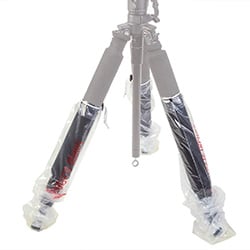 You can get insulating sleeves or pipe insulation for the legs of your tripod, such as the OP/TECH USA Tripod Sleeves Tripod Leg Covers [Amazon Link]. Alternatively, use a carbon fiber tripod to prevent ice burn, such as the Neewer Carbon Fiber 66 inches/168 centimeters Camera Tripod [Amazon Link].
You can get insulating sleeves or pipe insulation for the legs of your tripod, such as the OP/TECH USA Tripod Sleeves Tripod Leg Covers [Amazon Link]. Alternatively, use a carbon fiber tripod to prevent ice burn, such as the Neewer Carbon Fiber 66 inches/168 centimeters Camera Tripod [Amazon Link].
Include some silica gel desiccant [Amazon Link] in your camera bag to absorb residual moisture and any water from melted snow.
Make sure you get the snow off your camera and lens(es) before you bring them back inside. You do not want snow melting and having water get in your lens/body.
Acclimatize your camera! | Bringing your camera from outdoors to indoors (& vice versa)
Avoid rapid changes in temperature; limit the number of transitions from cold to warm, and vice versa.
When you must transition your camera from a cold to warm area, acclimatize the camera:
- Put your camera and lens back into the camera case
- Then put the camera case into a bag (any plastic bag that fits the case will do)
- Then go inside and leave the camera alone for a while in the case/bag until all reach room temperature. Following this process will minimize the chance that moisture will condense on the camera’s cold surfaces if brought too quickly into a warm room
If you cannot cover the camera case with a plastic bag, a simple towel can suffice. When you are finished shooting outside, wipe off the outside of the camera, the camera case and any other gear to remove any excess moisture.
Additional tip: turn the lens barrel to wipe off any moisture that may have gone under the outer barrel during times when the lens was retracted.
Best cameras for snow photography / blizzard-ready cameras
As a rule, do not use mechanical film cameras in the cold. These cameras are more susceptible to breaking, especially older ones. Always favour weather sealed cameras. Weather sealing a camera refers to having rubber gaskets in the seams to keep water from the camera’s internals. However, if the lens doesn't have weather sealing, water can still enter into the camera through the lens mount. Therefore, make sure to keep the lens mount dry.
Many cameras are already weather sealed, but don’t assume that your camera is necessarily weather sealed just because it’s a new model. Be sure to check with the camera manufacturer to verify.
The Pentax K-70 Black [Amazon Link] is fully weather sealed and has largely positive reviews on Amazon. This camera is built specifically for outdoor shooting. Another solid, less expensive option from this brand is the Pentax K-30 Weather-Sealed 16 MP CMOS Digital SLR [Amazon Link], which is also weather sealed and built for shooting outdoors.
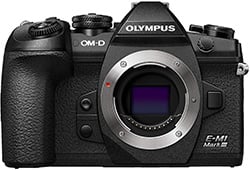 The Olympus OM-D E-M1 Mark III [Amazon Link] is rugged and durable; this camera can withstand water and snow spray with ease. The larger form factor also makes it easier to handle while wearing gloves.
The Olympus OM-D E-M1 Mark III [Amazon Link] is rugged and durable; this camera can withstand water and snow spray with ease. The larger form factor also makes it easier to handle while wearing gloves.
The Sony RX100 [Amazon Link] is tiny, but tough. You can easily stuff it inside a jacket pocket and keep your hands tucked away from the cold when not in use.
The Sony Alpha a6100 Mirrorless Digital Camera [Amazon Link] would be good for snow photography as it is more compact than traditional DSLRs and Sony claims that it has “the world’s fastest auto-focus”.
The Canon PowerShot G9X Mk II [Amazon Link] would be a good compact point-and-shoot option for snow photography. It is ultra slim and lightweight, so stuffing it inside a jacket pocket and pulling it out again for snow pictures would be quick and easy.
Finally, consider using a polarizing filter to cut down on glare from the snow, such as the Gobe 58mm Circular Polarizing (CPL) Lens Filter. [Amazon Link]
Some Snow Photographs | Snow Photography | Snow Photographer
Snow photography tip: Set your camera to overexpose by 1 1/3 to two stops. This will ensure that the snow actually looks white, not grey!
Maybe one of these nice snow pictures can help inspire you to do some snow photography of your own:
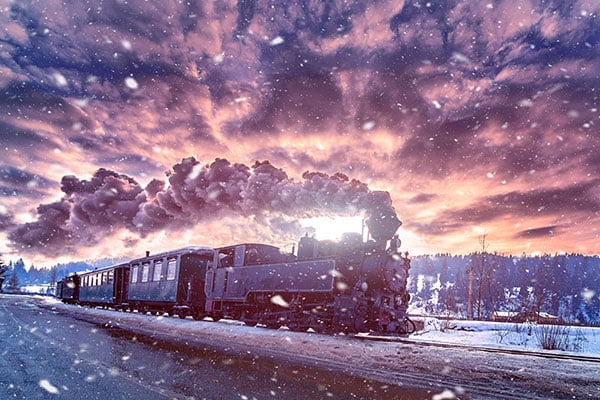
Mocănița steam train from Bucovina (Romania) travel in wintertime.
Shutterstock: Royalty-free stock photo ID: 1022616715
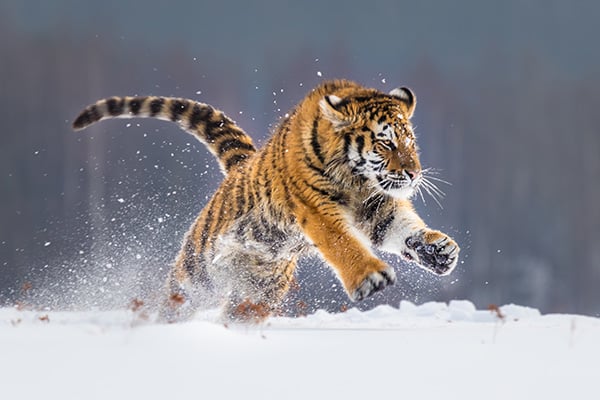
Siberian Tiger running in snow. Beautiful, dynamic and powerful photo of this majestic animal. Set in environment typical for this amazing animal. Birches and meadows.
Shutterstock: Royalty-free stock photo ID: 574476025
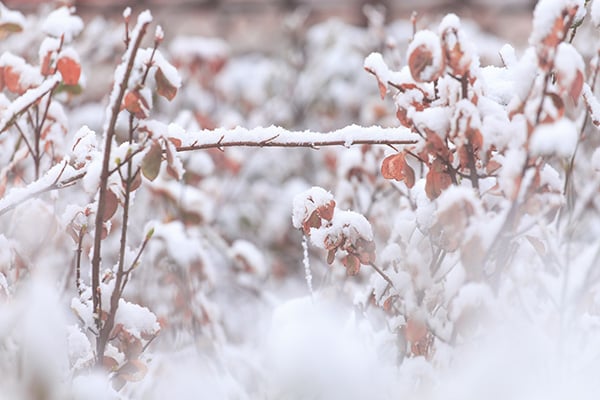
After the light snow in early spring.
Shutterstock: Royalty-free stock photo ID: 1253253541
Get Photography Insurance | Photography Equipment Insurance | Front Row Photography | Photographer Insurance
Following these tips will, hopefully, allow you to avoid snow-related damage to your photography gear. However, just in case something like that does happen, you will want to have photography insurance in place to help cover the cost of repair/replacement.
Front Row’s insurance for photographers (Canada) is a good option for insuring your photo gear. You can get a quote and purchase a policy online in a few minutes, or read more about the coverages available on the photography insurance site.
Refer a Friend to Front Row
Based on customer demand, we’ve setup our referral marketing program and if you refer a friend to Front Row, you could win a $15 Amazon eGift Card OR be entered into a random draw to win a $99 Amazon eGift Card! (depending on your province)
Related Posts:
FREE EBOOK! PHOTOGRAPHY INSURANCE 101: PROTECT YOUR CAMERA GEAR
PHOTOGRAPHY EQUIPMENT INSURANCE: YOU MAY NOT BE COVERED BY HOMEOWNERS
I’M JUST STARTING OUT IN MY PHOTOGRAPHY BUSINESS; DO I NEED INSURANCE?
4 QUESTIONS TO CONSIDER WHEN BUYING PHOTOGRAPHY BUSINESS INSURANCE
THEFT FROM VEHICLE: PHOTOGRAPHY INSURANCE EXPLAINED
PHOTOGRAPHERS & VIDEOGRAPHERS: SAVE MONEY ON YOUR CAMERA INSURANCE
HOW TO REDUCE THE COST TO INSURE YOUR PHOTOGRAPHY EQUIPMENT
HOW TO PROTECT YOUR CAMERA LENS(ES)
WHAT TO KNOW ABOUT RAIN PHOTOGRAPHY: PROTECTING YOUR CAMERA IN RAIN
UNDERWATER PHOTOGRAPHY BEST PRACTICES / IN-WATER PHOTOGRAPHY
PROTECT YOUR CAMERA GEAR FROM OVERHEATING
PROTECT YOUR CAMERA AT THE BEACH / PROTECT YOUR CAMERA FROM SAND
ORGANIZING YOUR CAMERA GEAR / KEEP TRACK OF YOUR PHOTOGRAPHY GEAR
INSURANCE FOR PHOTOS BOOTHS | PHOTO BOOTH INSURANCE FROM FRONT ROW
HOW DO I ADD AN ADDITIONAL INSURED TO MY POLICY?
5 THINGS TO KNOW ABOUT MAKING A PHOTOGRAPHY INSURANCE CLAIM
FRONT ROW: OFFERING ONLINE CAMERA INSURANCE POLICIES FOR PHOTOGRAPHERS
DISCLAIMER: Informational statements regarding insurance coverage are for general description purposes only. These statements do not amend, modify or supplement any insurance policy. Consult the actual policy or your broker for details regarding terms, conditions, coverage, exclusions, products, services and programs which may be available to you. Your eligibility for particular products and services is subject to the final determination of underwriting qualifications and acceptance by the insurance underwriting company providing such products or services. This website does not make any representations that coverage does or does not exist for any particular claim or loss, or type of claim or loss, under any policy. Whether coverage exists or does not exist for any particular claim or loss under any policy depends on the facts and circumstances involved in the claim or loss and all applicable policy wording.
Amazon Associates Disclosure: Front Row Insurance is a participant in the Amazon Services LLC Associates Program, an affiliate advertising program designed to provide a means for sites to earn advertising fees by advertising and linking to Amazon. This post may contain affiliate links. As an Amazon Associate, Front Row Insurance earns from qualifying purchases. There is no additional cost to you.

Submit a comment